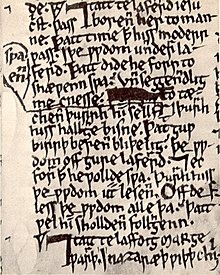Ormulum
The Ormulum or Orrmulum is a twelfth-century work of biblical exegesis, written by an Augustinian canon named Orrm (or Orrmin) and consisting of just under 19,000 lines of early Middle English verse.
Because of the unique phonemic orthography adopted by its author, the work preserves many details of English pronunciation existing at a time when the language was in flux after the Norman conquest of England.
Modern scholars have noted that the system reflected his concern with priests' ability to speak the vernacular and may have helped to guide his readers in the pronunciation of the vowels.
The linguistic contrast between it and the work of Orrm demonstrates both the sluggishness of the Norman influence in the formerly Danish areas of England and the assimilation of Old Norse features into early Middle English.
On the evidence of the third hand (that of a collaborator who entered the pericopes at the head of each homily) it is thought that the manuscript was finished c. 1180, but Orrm may have begun the work as early as 1150.
There is no doubt that such losses have occurred even in modern times, as the Dutch antiquarian Jan van Vliet, one of its seventeenth-century owners, copied out passages that are not in the present text.
[24] The theological content is derivative; Orrm closely follows Bede's exegesis of Luke, the Enarrationes in Matthoei, and the Glossa Ordinaria of the Bible.
[26] Bennett has speculated that the Acts of the Apostles, Glossa Ordinaria, and Bede were bound together in a large Vulgate Bible in the abbey so that Orrm truly was getting all of his material from a source that was, to him, a single book.
[27] Although the sermons have been deemed "of little literary or theological value"[28] and though Orrm has been said to possess "only one rhetorical device", that of repetition,[29] the Ormulum never was intended as a book in the modern sense, but rather as a companion to the liturgy.
Furthermore, although Orrm's poetry is, perhaps, subliterary, the homilies were meant for easy recitation or chanting, not for aesthetic appreciation; everything from the overly strict metre to the orthography might function only to aid oratory.
[31] Orrm was humble about his oeuvre: he admits in the preface that he frequently has padded the lines to fill out the metre, "to help those who read it", and urges his brother Walter to edit the poetry to make it more meet.
This passage explains the background to the Nativity: Rather than conspicuous literary merit, the chief scholarly value of the Ormulum derives from Orrm's idiosyncratic orthographical system.
[33] He states that since he dislikes the way that people are mispronouncing English, he will spell words exactly as they are pronounced, and describes a system whereby vowel length and value are indicated unambiguously.
He used insular <ᵹ> for the palatal approximant [j], a flat-topped <ꟑ> for the velar stop [ɡ], and a Carolingian
[38] The combination of this system with the rigid metre, and the stress patterns this meter implies, provides enough information to reconstruct his pronunciation with some precision; making the reasonable assumption that Orrm's pronunciation was in no way unusual, this permits scholars of the history of English to develop an exceptionally precise snapshot of exactly how Middle English was pronounced in the Midlands in the second half of the twelfth century.
As Bennett points out, Orrm's adaptation of a classical metre with fixed stress patterns anticipates future English poets, who would do much the same when encountering foreign language prosodies.

